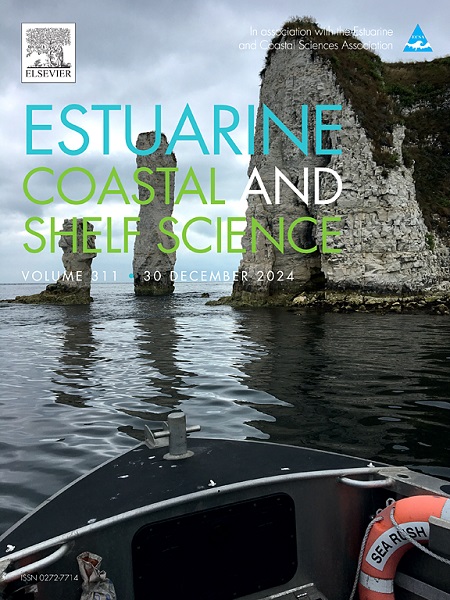Fish are more abundant in salt marsh creeks with a salinity gradient and low drainage capacity
IF 2.6
3区 地球科学
Q1 MARINE & FRESHWATER BIOLOGY
引用次数: 0
Abstract
Salt marsh conditions and morphology influence the ecological function of marsh habitats. However, little is known about how the interplay between these factors impacts fish in the highly modified marshes typical of north-western Europe. We conducted a two-year survey at two salt marsh areas in the Dutch Wadden Sea to test the influence of marsh creek morphology on in-creek abiotic conditions and the abundance of four numerically dominating fish species representing the different life-history strategies of fish in the marshes. We measured fish abundance and several abiotic factors seasonally, and quantified the morphological attributes of each creek (such as volume), and of the creek basin (such as drainage density and bathymetry). Modelling results revealed a salinity gradient and/or a greater capacity for water retention (creek volume or drainage density) were associated with higher abundances of Atlantic herring (Clupea harengus), European eel (Anguilla), gobies (Pomatoschistus sp.) and the three-spined stickleback (Gasterosteus aculeatus) across most seasons. During recruitment months sticklebacks and gobies were more abundant in brackish water conditions with a higher capacity for water retention. Eels were more abundant in creeks with larger volumes and lower salinities. Larval and juvenile herring were more numerous in brackish water than in water with higher salinity, but an effect of creek morphology on herring abundance was not detected. While recruitment processes were important determinants in the seasonal abundance of most species, creek morphology and abiotic conditions affected the use of salt marsh habitat by the fish species studied. Intertidal marsh creeks that retain water during low tide and have a salinity gradient hold more fish than marshes lacking these characteristics. These findings highlight the effects of local salt marsh conditions on fish assemblages. Taking the specific marsh conditions and their effects on fish into account in salt marsh management can improve outcomes for fish.
鱼类在盐度梯度大、排水能力低的盐沼溪流中更为丰富
盐沼的条件和形态影响着盐沼生境的生态功能。然而,对于这些因素之间的相互作用如何影响欧洲西北部典型的高度改造沼泽中的鱼类,人们知之甚少。我们在荷兰瓦登海的两个盐沼区进行了为期两年的调查,以测试沼泽溪流形态对溪流内非生物条件的影响,以及代表沼泽中鱼类不同生活史策略的四种数量上占主导地位的鱼类的丰度。我们按季节测量了鱼类丰度和几种非生物因子,并量化了每条小溪的形态属性(如体积)和溪流流域的形态属性(如排水密度和水深)。模拟结果显示,盐度梯度和/或更大的保水能力(小溪体积或排水密度)与大西洋鲱鱼(Clupea harengus)、欧洲鳗鱼(Anguilla)、虾虎鱼(Pomatoschistus sp.)和三棘棘鱼(Gasterosteus aculeatus)在大多数季节的丰度较高有关。在招募期间,鱼鱼和虾虎鱼在半咸淡水条件下数量更多,保水能力更强。鳗鱼在体积更大、盐度更低的小溪中更丰富。咸淡水中鲱鱼的幼鱼和幼鱼的数量比咸淡水中多,但没有发现小溪形态对鲱鱼丰度的影响。虽然补充过程是大多数物种季节性丰度的重要决定因素,但溪流形态和非生物条件影响了所研究鱼类对盐沼栖息地的利用。潮间带沼泽小溪在退潮时保留水分,具有盐度梯度,比缺乏这些特征的沼泽容纳更多的鱼。这些发现突出了当地盐沼条件对鱼类群落的影响。在盐沼管理中考虑特定的沼泽条件及其对鱼类的影响可以改善鱼类的结果。
本文章由计算机程序翻译,如有差异,请以英文原文为准。
求助全文
约1分钟内获得全文
求助全文
来源期刊
CiteScore
5.60
自引率
7.10%
发文量
374
审稿时长
9 months
期刊介绍:
Estuarine, Coastal and Shelf Science is an international multidisciplinary journal devoted to the analysis of saline water phenomena ranging from the outer edge of the continental shelf to the upper limits of the tidal zone. The journal provides a unique forum, unifying the multidisciplinary approaches to the study of the oceanography of estuaries, coastal zones, and continental shelf seas. It features original research papers, review papers and short communications treating such disciplines as zoology, botany, geology, sedimentology, physical oceanography.

 求助内容:
求助内容: 应助结果提醒方式:
应助结果提醒方式:


